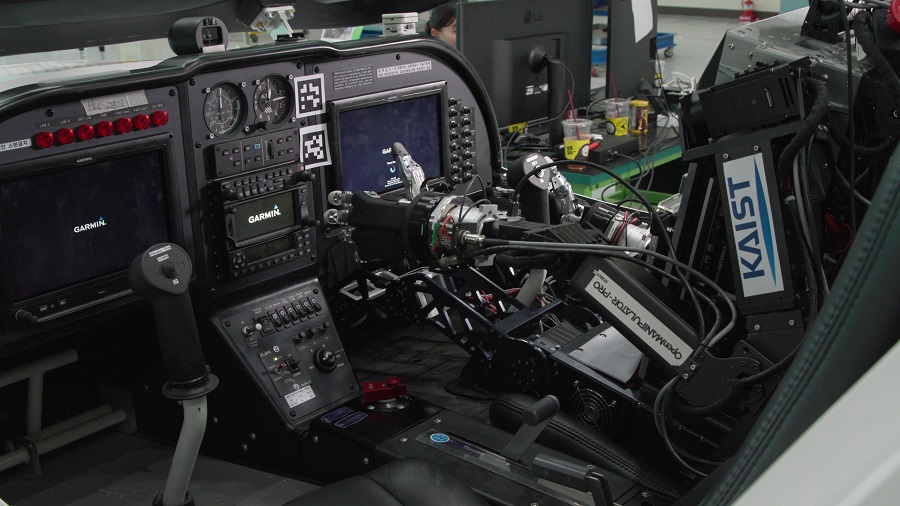A team of innovative researchers from the Korea Advanced Institute of Science & Technology (KAIST) has broken new ground by developing a humanoid robot capable of piloting an aircraft, named Pibot. It’s designed to control and fly a conventional airplane from takeoff to landing without requiring significant modifications to the cockpit. Pibot’s sophisticated AI system, combined with its human-like form, allows it to seamlessly interact with the cockpit controls, making it an impressive breakthrough in aviation technology.
The Artificial Intelligence Behind Pibot
At the heart of Pibot’s capabilities is its advanced artificial intelligence (AI) system, which enables it to mimic the actions and decision-making processes of a human pilot. The robot stands at 5 feet 3 inches (160 cm) tall and weighs approximately 143 lbs (65 kg). Pibot is placed in the cockpit, where it performs the same functions as a human pilot by manipulating all the necessary controls to operate an airplane. This includes maintaining the correct altitude, adjusting the aircraft’s thrust, and following a flight path.
Join us on TELEGRAM for the Latest Aviation Updates fresh to your phone.
KAIST researchers emphasize that Pibot’s AI-driven technology offers precision in handling various controls and managing inputs during flight. Its performance is enhanced by its ability to communicate effectively with Air Traffic Controllers (ATC) and other humans involved in the flight process. Pibot can receive and execute ATC commands, ensuring that it follows safety procedures, particularly during crucial stages of the flight, such as takeoff and landing.
Navigating Harsh Conditions
One of the most outstanding features of Pibot is its ability to manage flight operations during extreme conditions. Aircraft turbulence, control vibrations, and harsh environmental factors often pose significant challenges for pilots. However, Pibot is designed to handle such situations with ease. According to Dr. David Hyunchul Shim, one of the lead professors involved in the project, “Pibot’s human form may not be super efficient, but they designed it to be a humanoid form since everything in the cockpit is built for humans.”

This human-like form allows Pibot to operate the controls efficiently, even when faced with severe turbulence. Pibot’s highly precise technology ensures that it can maintain control of the aircraft under adverse conditions, providing a level of reliability comparable to, if not surpassing, human pilots.
Superior Control and Communication
Pibot is equipped with multiple built-in cameras, enabling it to monitor and evaluate the aircraft’s performance throughout the flight. Unlike an autopilot system, which primarily relies on pre-programmed tasks, Pibot is capable of dynamic decision-making. It adjusts its actions according to real-time conditions, ensuring that all necessary control switches are operated without delay. Additionally, Pibot’s ability to synthesize speech allows it to communicate with both ATC and any humans present in the cockpit.
This AI-powered robot represents a significant departure from conventional autopilot systems or unmanned aerial vehicles (UAVs). While autopilot systems are designed to manage certain routine aspects of flight, Pibot is capable of making complex decisions that reflect human cognitive processes. Furthermore, it differs from UAVs, which are typically pre-programmed and monitored from the ground. Instead, Pibot brings decision-making onboard, responding directly to the flight environment.
A Memory Like No Other

Pibot’s AI goes beyond simple flight operations. The robot is designed to memorize vast amounts of data, far exceeding human capabilities. From complex navigational information and detailed flight plans to alternative routes in case of emergencies, Pibot can access and utilize extensive datasets, offering a level of preparedness that human pilots can’t match.
Another key advantage of Pibot is its elimination of the human emotional factor. Human emotions, stress, and fatigue can sometimes lead to critical errors during flight. With Pibot, the possibility of such errors is greatly reduced, as it relies solely on logic, data, and programmed decision-making algorithms. This precision-driven approach enhances flight safety, reducing the likelihood of human-induced incidents.
Testing and Future Plans

Pibot has already demonstrated its abilities in flight simulations, where it successfully managed every phase of flight, from takeoff to landing. The next step for the KAIST research team is to put Pibot to the test in a real-world setting by flying an actual light aircraft within the next few years.
This revolutionary robot is poised to change the future of aviation, offering potential solutions for pilot shortages and enhancing the safety and reliability of air travel. While there are still tests and improvements to be made, the future looks bright for this AI-powered humanoid pilot.
Pibot’s introduction to the aviation industry is likely to spark new conversations about the role of AI in flight, the potential for replacing human pilots in certain situations, and how this technology could transform the entire aviation landscape.
What are your thoughts on Pibot, the humanoid robot capable of flying an airplane? Share your opinions in the comments section below!
Sources:
Youssef Yahya is the CEO and Founder of Aviation for Aviators. He also serves as the Chief-in-Editor of the platform’s website, where he shares his passion for aviation and provides valuable resources for aviation enthusiasts and professionals alike. His love for aviation and entrepreneurial spirit drive him to create innovative solutions, making Aviation for Aviators a unique resource in the aviation sector.
You might also like:
- How did Aviation Changed Life?
- Video: Cargolux Boeing 747 Damaged During Landing at Luxembourg
- Boeing To Restart Manufacturing Operations in China
- What are the functions of external aircraft lights?
- Tara Air Flight Crashes With 22 People On Board
Discover more from Aviation for Aviators
Subscribe to get the latest posts sent to your email.

